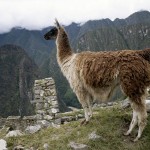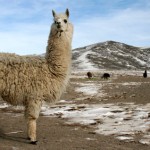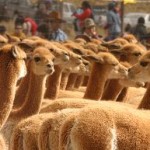Peru Camels
September 17, 2011Llamas
Domesticated in the Lake Titicaca region more than 6,000 years ago, the llama (llama glama), at 250 to 400 pounds(114-182 kgs) and up to 6 feet (2m) tall, was the largest domesticated animal on the continent until the Spaniards arrived with their horses and cattle. Historically used for the transportation of goods, llamas still work as baggage animals today, carrying as much as 50 pounds (22.5 kg). To the amazement of the Inca, early Europeans attempted to ride these diminutive beasts. The llamas, distressed by the extra weight upon them, would twist their neck and spit at the riders, leading to to popular myth that llamas generally spit at people. In fact, llamas are more likely to spit at rivals during mating season than at humans.
The indigenous people of Peru, who regularly ate the llama’s tought meat, used the animal’s coarse fur for ropes or rough yam and its dried dung as fuel. A vital part of everyday life, llamas were sacrificed to Inti, the Inca sun god, and to other gods by pre –Incan cultures.
Alpacas
Domesticated soon after the llama, alpacas (lama pacos) were raised for their fine wool. Softer than most sheep wool, alpaca fleece is sought- after the world over, and alpaca farms have sprung up in North America, Europe and Australia, About 80 porcent of the world estimated four millions alpacas live in the highlands of southern Peru, where they form a major part of the economy of highland campesinos ( peasants). Formerly eaten only by poor campesinos, alpaca meat– high in protein, low in fat and cholesterol – has recently earned a place in the fashionable Novoandina (new Andean) cuisine.

Vicuña and Guanacos
Peru s smallest camelid, the delicate and skittish vicuña( Vicugna vicugna), has the finest wool in the world, and its golden coat and white belly make it the prettiest of the four species. Its wool is sheared during chaccus (ceremonial roundups) in late May or June, after which the animals are released back in to the wild. In Inca times, only nobles wore the luxurious wool. After the Spanish conquest, however, the wool was more widely used and their numbers dwindled.
By the mid- 20th century, the vicuña was in danger of extinction. As a result, reserves such as Pampas Galeras above Nasca and Salinas y Aguada Blanca near Arequipa established conservation programs. By 1995, the number of vicuñas had recovered sufficiently to permit shearing once again, which in turn aided the growth of local economies profiting from the sale of the wool. Today there are more than 100,000 vicuñas in Peru.
For more information and interesting articles about Peru, please take some time to look through our Peru guide.
YOU MAY LIKE

Lima to Machu Picchu – Agencies DON’T want you to read this!

#1 Rated Day Trips From Lima To Unforgettable Destinations

Everything You Need to Know to Avoid the Typical Tourist Mistakes At Machu Picchu

What NOT To Do When Visiting Rainbow Mountain

Spend 50% less and see 100% more in Peru

Machu Picchu Tickets – All You Need To Know!

These Hidden Destinations Just Outside Of Lima Will Blow Your Mind!

Peru – How to Avoid Being a Typical Tourist

OFFICIAL: This Company Was Voted The Best Way To Get Around Peru

Peruvian Travel Secrets That Only The Locals Know





